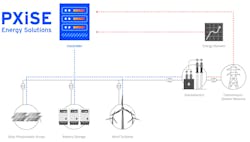Smart Controllers Could Help Texas Grid Woes
In recent years, Texas’ electrical grid has struggled to meet demand, a situation that becomes especially dire during times of high stress. When the winter storm of 2021 knocked large parts of the grid out of commission, millions of homes were left without power for days of grindingly cold temperatures. Mass blackouts were avoided during a sweltering summer that year, but mainly because the state spent extra to increase reserve capacity and incentivize customers to lower their usage.
According to the U.S. Energy Information Administration, Texas is the country’s largest electricity consumer, with its industrial sector accounting for more than one-half of the state’s energy consumption. With Texas’ grid isolated from the rest of the country’s grids, the Electric Reliability Council of Texas (ERCOT), which manages the power supply for over 26 million Texans, faces an uphill battle in ensuring the state’s grid is prepared to meet capacity constraints. With a warming climate, an increasing likelihood of severe winter storms and one of the country’s fastest-growing populations, supply issues will only grow worse in the years to come.
Fast Frequency Response
Adding new utility-scale power plant projects and upgrading T&D networks are the most obvious ways to increase capacity, but to do so in a meaningful manner requires expensive and lengthy infrastructure projects. Adding adaptable energy resources is one way to expand the capability of the grid in the short term, and energy storage is one of the easiest ways to do this. Utility-scale batteries can be connected to the grid to expand existing capacity, storing energy when demand is low and providing a reserve supply when it is high. Energy storage also is useful as a source of backup power, so the lights and heat can keep running when the next winter storm strikes or the air conditioning can keep churning when a heat wave is on the brink of inducing brownouts.
ERCOT introduced the fast frequency response (FFR) market in response to reductions observed in system inertia because of increased renewable penetration. Inverter- or asynchronous-based power resources like wind turbines, solar photovoltaics and battery storage do not provide system inertia, but they do offer alternative benefits, including, in the case of energy storage, the ability to provide instant on-demand power injections to the grid. When inverter-based resources can be dispatched instantly, they can mitigate frequency fluctuations that lead to power disruptions and grid instability.
The FFR market incentivizes fast-responding assets like storage to be ready for dispatch instantly, effectively reducing the need for system inertia provided by spinning generators.
ERCOT’s requirements state an FFR resource must be automatically deployed within 15 cycles (hertz) after grid frequency reaches the trigger threshold. A resource also must sustain the response for at least 15 minutes or until ERCOT recalls deployment when the desired frequency is reached, whichever occurs first. A resource must be reset and made available for the next event within 15 minutes after deployment is ended. These FFR requirements can be handled by an energy storage system controller that can sense the grid’s frequency — using high-speed measurements such as synchro-phasors — and automatically command the battery energy storage system under its control to discharge a set amount of energy for a sustained amount of time and reset itself per ERCOT’s needs.
The high bar ERCOT has established for assets providing ancillary services such as frequency response, while borne out of necessity to keep Texas’ grid stable, means operators with utility-scale storage now have an opportunity for additional revenue sources. By installing a controller that meets ERCOT’s FFR standards, developers can provide an additional revenue stream for operators, making the case for installing energy storage that much stronger.
New Generation Of Controllers
Recent developments among controller developers mean there are now options, albeit limited, that meet ERCOT’s FFR requirements. Power plant controllers (PPCs) are a particularly useful solution for renewable power plant operators interested in adding energy storage to their portfolio. A PPC autonomously can control the real and reactive power of one or multiple resources, as measured at the point of interconnection (POI), to support multiple use cases, such as energy and ancillary service markets, including ERCOT’s FFR market.
Because a PPC is managing all the resources of a project, rather than individual inverter controls, the PPC can holistically look at the capabilities of all resources
under control to provide coordinated support to the grid connection point. Of note for Texas, as the country’s largest source of wind generation, PPCs also can manage power from wind farms and wind-plus-storage projects.
Time-synchronized phasor measurement units (PMUs) are an ideal tool to measure system frequency, as they offer high-speed, precise data that, when leveraged by a smart controller, provide the measurement data to meet and exceed the FFR market response threshold. Additionally, these capabilities typically are included in devices already installed at a project, so no additional measurement hardware is required. A PPC such as PXiSE Energy Solutions’ renewable PPC relies on PMU data — processing it as soon as it is captured, at the same speed as the 60-Hz grid — and can manage any mix of renewables and energy storage. It also enables operators who wish to participate in the ERCOT energy market to do so in addition to the FFR market, as the control software can adapt autonomously to multiple types of resources and different batteries on a single system for parallel use cases.
Smart Controllers
The availability of controllers that meet ERCOT’s FFR requirements means energy storage project economics can be improved for project developers — and power plant operators looking for additional revenue streams. Investing in a high-speed controller that is software based de-risks the project for future market requirements, as software can be easily adapted to meet new requirements. A smart controller with advanced capabilities can even provide control for markets yet to be defined.
It may take years of building power plants and investing in T&D to meet the growing energy needs of Texans, but in the meantime, smart controllers that can enable storage project owners to participate in ERCOT’s various markets, like FFR, have made the case for adding battery energy storage in Texas stronger than ever.
ELLIOT STEIN is a technical sales manager at PXiSE Energy Solutions. In this position, he leverages his background in both renewable and electric utility industries to find solutions for clients’ energy management and control challenges. Before joining PXiSE, Stein held engineering and technical roles for the development and construction of solar, wind and storage projects at multiple utility scale project developers and owner operators. He also spent five years in T&D system protection and substation operations and commissioning at an investor-owned electric utility. Stein has a wide-ranging technical background and is focused on using it to accelerate the implementation and deployment of advanced grid control solutions.
About the Author
Elliot Stein
Elliot Stein is a technical sales manager at PXiSE Energy Solutions. In this position, he leverages his background in both renewable and electric utility industries to find solutions for clients’ energy management and control challenges. Before joining PXiSE, Stein held engineering and technical roles for the development and construction of solar, wind and storage projects at Sempra Renewables, ConEdison Clean Energy Businesses, and Matrix Renewables. He also spent five years in T&D system protection and substation operations and commissioning at the electric utility Pepco Holdings. Stein has a wide-ranging technical background and is focused on using it to accelerate the implementation and deployment of advanced grid control solutions.

